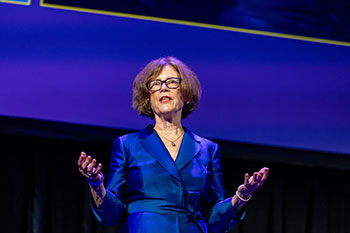
With the title “Innovation: It’s in Our DNA,” Colleen Kigin, PT, DPT, MS, MPA, FAPTA, presented the 52nd Mary McMillan Lecture on Sept. 12 as part of APTA’s centennial celebration. And while she affirmed that being innovative certainly is “in our DNA” as physical therapists and physical therapist assistants, the events of the past 18 months have made it clear that the time is now to surface that innovation from being “recessive” to being and remaining “dominant.”
“If we sideline or let innovation be a secondary focus, we will miss the future of what our patients need for the job to be done … Our vision states we will meet their needs, and we must continue to innovate to bring that vision to life,” she said.
The profession is rich with innovators, including Mary McMillan herself, Kigin said, quoting the association’s founder from her 1922 presidential address: “The easy path in the lowland has nothing of grand or new; but a toilsome ascent leads on to a glorious view.”
McMillan and other innovators displayed several skills and characteristics, Kigin said, picking out three to describe. First, she said, it takes courage to innovate: It requires taking risks and being willing to fail, as well as to succeed.
Second, innovation requires an environment that supports a culture for creativity — a safe environment where no person’s viewpoints or questions are stupid or not important.
Finally, innovation involves fostering essential behavioral skills; Kigin focused on these five:
- Associating: Innovators are able to connect the unconnected or make surprising connections.
- Questioning: Innovators ask lots of questions and, equally important, they are receptive to questions posed by others.
- Observing: Innovators are intense observers, noting what works and what doesn’t.
- Networking: Innovators broaden their reach to people of different backgrounds, perspectives, and professions.
- Experimenting: The innovator’s practice site, educational institution, or office is their laboratory, where they test, gather outcomes, and share data.
Kigin provoked thought with three of what she called innovation “imagines” — opportunities for the profession to broaden its innovative efforts and culture. Under the scenario of the COVID-19 health emergency, she posited the first “imagine”: Imagine that we establish a national repository focused on a critical problem such as measuring outcomes of those experiencing long-term issues post COVID-19. The already established Physical Therapy Outcomes Registry could be “just the vehicle needed for housing this national database,” she proposed. The initiative would promote our collaboration with other established database efforts, such as though the National Institutes of Health, and would give the physical therapy profession recognition as leaders in such efforts.
Moving away from the COVID-19 health emergency, Kigin said that as essential as innovation has been during the pandemic, it is every bit as important outside a crisis as within one. She suggested that to achieve a longstanding goal of the profession — to be a clinician throughout the lifetime of our patients — we must develop ongoing, real-time access to important data regarding patients’ responses to treatment, “not just during treatment, but on a continuous basis, where they live, work, and, yes, fall.”
This led to her second “imagine”: Imagine having this ongoing information through the integration of telehealth and wearable biosensors. Advantages of using these technologies, she said, include enhanced patient motivation and a way to address social inequities for those who can’t easily travel to receive services. She suggested forming a think tank among health disciplines, other industries, and patients, with our profession being front and center to the work. “If we do not help advance these technologies,” she warned, “others will move ahead without us.”
Kigin next addressed the “how” — how can these and other goals be accomplished? In her third “imagine” she called for establishing collaboratives or frameworks that are accessible to members and partners, to promote the culture and process of innovation.
She recognized existing efforts toward such a goal, including the APTA Frontiers in Rehabilitation, Science, and Technology Council; the association’s 2015 innovation grant program; and the Health Policy and Administration Section’s TechnoPalooza event during APTA Combined Sections Meeting. She also gave an emphatic nod to the Foundation for Physical Therapy Research and APTA’s sections and academies for providing grants to new and experienced researchers.
Regardless of this collaboration’s structure, Kigin said three elements were essential:
- Developing and growing a culture of innovation, as it is at the heart of any successful collaborative effort.
- Identifying major areas of opportunity or unmet challenges, a process that is ongoing and able to pivot.
- Establishing and broadening our outreach to other health professions; to engineers and scientists; to established innovation centers; to industry, such as Google Health, Fitbit, and Apple; to policy makers; and, most important, to patients and patient advocacy groups.